wagons
 When people started moving west in the United States, the trips took approximately four months by wagon train. At that time, saying “goodbye” to loved ones was a very sad moment, because many times people would never see each other again. The distance was just too great and the cost too much, and unless people were moving permanently, they simply couldn’t take the trip. At that time…the 1860s, they likely had no idea that things would get easier either.
When people started moving west in the United States, the trips took approximately four months by wagon train. At that time, saying “goodbye” to loved ones was a very sad moment, because many times people would never see each other again. The distance was just too great and the cost too much, and unless people were moving permanently, they simply couldn’t take the trip. At that time…the 1860s, they likely had no idea that things would get easier either.
Nevertheless, just a short sixteen years later, all that changed. The train wasn’t a completely new invention in the 1860s, and in fact was invented in 1829. Still, as the United States was experiencing its expansion to the west, there were few towns and no railroads. So, moving west still meant that families might never see their departing loved ones again, and if the did, it would be a number of years. During the early 19th century, when Thomas Jefferson first dreamed of an American nation stretching from “sea to shining sea,” it took the president 10 days to travel the 225 miles from Monticello to Philadelphia via carriage. The distance from New York to San Francisco (which was founded in 1776, but didn’t become part of the United States until the signing of the Treaty of Guadalupe Hidalgo in 1848). Jefferson was president from 1801 to 1809. The distance from New York City to San Francisco is 2,565 miles from New York City, making the carriage time in those days approximately 114 days, or a little less than a third of a year. If you weren’t moving west, you would also have to make the return trip. It just wasn’t feasible.
Jefferson saw a possible answer to his dilemma as early as 1802, with “the introduction of so powerful an agent as steam.” At that time, he predicted, the possibility of “a carriage on wheels” that would make “a great change in the situation of man.” For Jefferson, the change would not come soon enough, and he never witnessed the 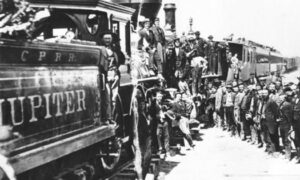 “carriage on wheels” he had envisioned. Nevertheless, within half a century, America would have more railroads than any other nation in the world, and by 1869, America would see the first transcontinental line linking the coasts was completed. Now, those journeys that were impossible for any reason but moving, that had previously taken months using horses, could be made in less than a week. In fact, on June 4, 1876, the Transcontinental Express train traveled from New York City to San Francisco in a mere 83 hours.
“carriage on wheels” he had envisioned. Nevertheless, within half a century, America would have more railroads than any other nation in the world, and by 1869, America would see the first transcontinental line linking the coasts was completed. Now, those journeys that were impossible for any reason but moving, that had previously taken months using horses, could be made in less than a week. In fact, on June 4, 1876, the Transcontinental Express train traveled from New York City to San Francisco in a mere 83 hours.
It seemed inconceivable that a human being could travel across the entire nation in less than four days. Nevertheless, now the impossible had become not only possible, but a reality, and the United States became a very mobile nation. Prior to that time, the coast were months apart, and it was speculated that the nation couldn’t possibly stay united. They couldn’t even communicate very well, much less see each other. Now, those problems were in the past. Just five days later, daily passenger service began. You simply can’t hold progress back. Once the technology is available, the reality isn’t far behind. Americans were amazed at the speed and comfort of this new form of travel. Of course, it wasn’t for everyone, because as with all new inventions, it was expensive and therefore, only for the wealthy. The train was luxurious, with first-class passengers riding in beautifully appointed cars with plush velvet seats that converted into snug sleeping berths. The finer amenities included steam heat, fresh linen daily and gracious porters who catered to their every whim. For an extra $4 a day, the wealthy traveler could opt to take the weekly Pacific Hotel Express, which offered first-class dining on board. As one happy passenger wrote, “The rarest and richest of all my journeying through life is this three-thousand miles by rail.”
A third-class ticket could be purchased for only $40–less than half the price of the first-class fare. At this low rate, the traveler received no luxuries. Their cars, fitted with rows of narrow wooden benches, were congested,  noisy and uncomfortable. The railroad often attached the coach cars to freight cars that were constantly shunted aside to make way for the express trains. Consequently, the third-class traveler’s journey west might take 10 or more days. Still, no one complained, because 10 days was far better than four months, and sitting on a hard bench seat was still much better than six months walking alongside a Conestoga wagon on the Oregon Trail. Of course, this amazing method of transportation would only be amazing for a short time in history, as trains gave way to cars and eventually airplanes. Still those things were either a way off, or would have to wait for the necessary roads and airports to make those forms of travel available. Trains were here now, and life was good!!
noisy and uncomfortable. The railroad often attached the coach cars to freight cars that were constantly shunted aside to make way for the express trains. Consequently, the third-class traveler’s journey west might take 10 or more days. Still, no one complained, because 10 days was far better than four months, and sitting on a hard bench seat was still much better than six months walking alongside a Conestoga wagon on the Oregon Trail. Of course, this amazing method of transportation would only be amazing for a short time in history, as trains gave way to cars and eventually airplanes. Still those things were either a way off, or would have to wait for the necessary roads and airports to make those forms of travel available. Trains were here now, and life was good!!
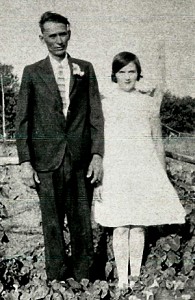 One hundred and twenty three years ago yesterday, my grandfather, George Byer was born. His life would take many twists and turns. It would span two world wars, as well as other wars. He would live during two different centuries. He would see the transition from wagons to cars, and also the transition to airplanes. He would marry the love of his life, Hattie Pattan on Christmas Eve, and I think he always felt like she was the best Christmas present he ever received. He loved her so much. She and his family were the top priority to him. Grandpa loved kids, and they wanted a large family. They had nine children.
One hundred and twenty three years ago yesterday, my grandfather, George Byer was born. His life would take many twists and turns. It would span two world wars, as well as other wars. He would live during two different centuries. He would see the transition from wagons to cars, and also the transition to airplanes. He would marry the love of his life, Hattie Pattan on Christmas Eve, and I think he always felt like she was the best Christmas present he ever received. He loved her so much. She and his family were the top priority to him. Grandpa loved kids, and they wanted a large family. They had nine children.
My best memories of Grandpa are of his gentle ways. He always called us kid. It was  never meant in a generalizing way, it was his way of being endearing, and you always knew that. You always knew that Grandpa loved being a grandpa. He loved spending time around his grandkids. I remember him stopping by our house. My sisters and I were so excited to see him. He was fun to play games with, and never made us feel like we were in the way. He just loved kids, especially his grandkids.
never meant in a generalizing way, it was his way of being endearing, and you always knew that. You always knew that Grandpa loved being a grandpa. He loved spending time around his grandkids. I remember him stopping by our house. My sisters and I were so excited to see him. He was fun to play games with, and never made us feel like we were in the way. He just loved kids, especially his grandkids.
As his life was coming to a close, there were times that he didn’t remember who we were. It’s strange when your grandfather recognizes your husband before he does you. 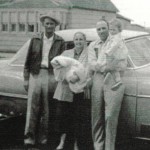 That was what happened though, he thought I was the nurse, but he knew my husband’s name. It was because of a trip we took him on. Bob was so good with Grandpa’s worries. He explained the map and showed Grandpa where we were and where we were going, on a trip we took to take them to Cascade, Idaho, where they had family. It was a trip that apparently meant a lot to Grandpa, and he was grateful to Bob for putting his mind at ease, in those later years. Yes, Grandpa’s life took many twists and turns, but I seriously doubt if he would have changed a thing. It was his life, and he loved it. It’s hard to believe that grandpa would have been 123 years old yesterday. I know you had a wonderful day Grandpa. We love you and miss you very much.
That was what happened though, he thought I was the nurse, but he knew my husband’s name. It was because of a trip we took him on. Bob was so good with Grandpa’s worries. He explained the map and showed Grandpa where we were and where we were going, on a trip we took to take them to Cascade, Idaho, where they had family. It was a trip that apparently meant a lot to Grandpa, and he was grateful to Bob for putting his mind at ease, in those later years. Yes, Grandpa’s life took many twists and turns, but I seriously doubt if he would have changed a thing. It was his life, and he loved it. It’s hard to believe that grandpa would have been 123 years old yesterday. I know you had a wonderful day Grandpa. We love you and miss you very much.
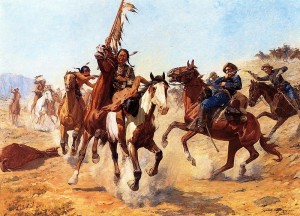 I don’t always think of myself as living in a historic area, although I should, because during the days of the Old West, at least, much history happened here. In fact, on this day, July 28, 1865, twenty year old Caspar Collins…a gutsy lieutenant from Dogwood Knob and Hillsboro, Ohio led 20 men to fight a battle against 1,000 to 3,000 Indians, just outside Platte Bridge Station, which was near Casper, Wyoming, where I live. The battle had been coming, and everyone knew it. The Lakota Sioux and the Cheyenne Indians had been attacking the United States Army for a couple of months now. The Indians had raided outposts and stagecoach stations over a wide area of Wyoming. On this day back in 1865, the Indians assembled their warriors and descended on Platte Bridge Station. The Platte River bridge was guarded by 120 men near the bridge, and another 28 soldiers guarded a wagon train a few miles away. The Indians killed 29 soldiers, while only losing 8 warriors in the raid.
I don’t always think of myself as living in a historic area, although I should, because during the days of the Old West, at least, much history happened here. In fact, on this day, July 28, 1865, twenty year old Caspar Collins…a gutsy lieutenant from Dogwood Knob and Hillsboro, Ohio led 20 men to fight a battle against 1,000 to 3,000 Indians, just outside Platte Bridge Station, which was near Casper, Wyoming, where I live. The battle had been coming, and everyone knew it. The Lakota Sioux and the Cheyenne Indians had been attacking the United States Army for a couple of months now. The Indians had raided outposts and stagecoach stations over a wide area of Wyoming. On this day back in 1865, the Indians assembled their warriors and descended on Platte Bridge Station. The Platte River bridge was guarded by 120 men near the bridge, and another 28 soldiers guarded a wagon train a few miles away. The Indians killed 29 soldiers, while only losing 8 warriors in the raid.
In reality, the Army was unprepared for this attack or the ones leading up to it. Colonel Thomas Moonlight had led a 500 Cavalry force out to seek out and punish the raiding Indians on May 26, 1865. He hung to minor Oglala leaders…Two Face and Black Foot. He left them hanging for days. I’m sure this infuriated the Indians. On June 3, the army began to worry that the 1,500 Lakota, mostly Brulé, and Arapaho who were living near Fort Laramie, might become hostile. So they decided to move them about 300 miles east to Fort Kearny in Nebraska. The Indians protested that Fort Kearny was in the territory of their traditional enemies, the Pawnee. The next day, near present day Morrill, Nebraska, most of the Indians refused to accompany the soldiers and  began crossing the North Platte River, assisted by Crazy Horse and a band of Oglalas on the other side. Attempting to stop them, Captain William D. Fouts and four soldiers were killed. Informed of the disaster, Moonlight departed Fort Laramie with 234 cavalry to pursue the Indians. He traveled so fast that many of his men had to turn back because their horses were spent. On June 17, near present day Harrison, Nebraska, the Lakota raided his horse herd and relieved him of most of his remaining horses. Moonlight and his men had to walk 60 miles back to Fort Laramie. He was severely criticized by his soldiers for being drunk and not setting a guard on his horses. On July 7, Moonlight was relieved of his command and mustered out of the army.
began crossing the North Platte River, assisted by Crazy Horse and a band of Oglalas on the other side. Attempting to stop them, Captain William D. Fouts and four soldiers were killed. Informed of the disaster, Moonlight departed Fort Laramie with 234 cavalry to pursue the Indians. He traveled so fast that many of his men had to turn back because their horses were spent. On June 17, near present day Harrison, Nebraska, the Lakota raided his horse herd and relieved him of most of his remaining horses. Moonlight and his men had to walk 60 miles back to Fort Laramie. He was severely criticized by his soldiers for being drunk and not setting a guard on his horses. On July 7, Moonlight was relieved of his command and mustered out of the army.
The Platte River bridge was a key crossing point of the North Platte River for wagon trains of emigrants traveling the Oregon and Bozeman Trails. The Indians wanted to stop traffic on the Bozeman Trail which led through the heart of their hunting territory. The bridge had been constructed in 1859 and was almost 1,000 feet long and 17 feet wide. On July 20, Indian leaders made their final decision to launch an attack against the bridge. The warriors gathered and set out southward from the mouth of Crazy Woman Creek on the Powder River. The Platte River Bridge was 115 miles south. The army was the largest they had ever seen. It was estimated to number 3,000 men. U.S. army accounts state that the wagons were forced into a hollow where they held out for four hours, using fire from Spencer rifles to repel assaults until a large group closed on foot and overwhelmed the defenders, killing all.
Then came the attack of Platte Bridge Station. The battle that left 29 men dead…including Lieutenant Caspar 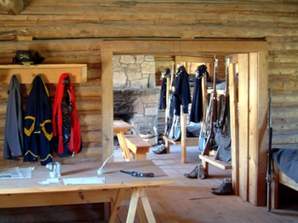 Collins, and at least 10 more men seriously injured. The battles before had involved maybe 1000 Indians. This battle was different…this one involved 3000. They were seriously outnumbered, but Lieutenant Caspar Collins went out to fight anyway. The day after the battle, the Indian army broke up into small groups and dispersed. A few remained near the Oregon Trail for raiding but most returned to their villages in the Powder River country for their summer buffalo hunt. Indians lacked the resources to keep an army in the field for an extended period of time. The Army officially renamed Platte Bridge Station to Fort Caspar to honor Collins, using his given name to differentiate the post from an existing fort in Colorado named after Collins’ father.
Collins, and at least 10 more men seriously injured. The battles before had involved maybe 1000 Indians. This battle was different…this one involved 3000. They were seriously outnumbered, but Lieutenant Caspar Collins went out to fight anyway. The day after the battle, the Indian army broke up into small groups and dispersed. A few remained near the Oregon Trail for raiding but most returned to their villages in the Powder River country for their summer buffalo hunt. Indians lacked the resources to keep an army in the field for an extended period of time. The Army officially renamed Platte Bridge Station to Fort Caspar to honor Collins, using his given name to differentiate the post from an existing fort in Colorado named after Collins’ father.
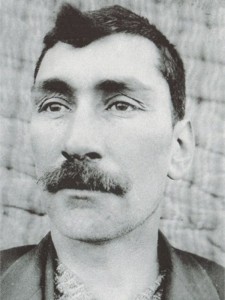 Like many people, my great grand uncle, Cornealius Spencer and his wife Leola Stinson Spencer left Iowa and made their way to Oklahoma in the spring of 1893. With them were their children and Leola’s parents. They had heard that the government was giving away land and they had decided to make a new start. The homestead they received was 160 acres, but the land came with qualifications. The homestead owner was required to fence the land, build a building, and live on the land for a period of one year before it became theirs. When I think of those reasonable qualifications, in light of today and all we have now, I think that the land they received was really cheap…and maybe it was, but times were different then, and living on a piece of land that had no improvements, and the soil was hard and rocky, might not have been so easy. They didn’t have the farming equipment we have now, so they had to till the ground with a team of horses or a yoke of oxen and a hand plow. They couldn’t just run down to the lumber store to buy building supplies. They had to cut down their own logs to build a home, or live in a sod hut…which many people then did for a time.
Like many people, my great grand uncle, Cornealius Spencer and his wife Leola Stinson Spencer left Iowa and made their way to Oklahoma in the spring of 1893. With them were their children and Leola’s parents. They had heard that the government was giving away land and they had decided to make a new start. The homestead they received was 160 acres, but the land came with qualifications. The homestead owner was required to fence the land, build a building, and live on the land for a period of one year before it became theirs. When I think of those reasonable qualifications, in light of today and all we have now, I think that the land they received was really cheap…and maybe it was, but times were different then, and living on a piece of land that had no improvements, and the soil was hard and rocky, might not have been so easy. They didn’t have the farming equipment we have now, so they had to till the ground with a team of horses or a yoke of oxen and a hand plow. They couldn’t just run down to the lumber store to buy building supplies. They had to cut down their own logs to build a home, or live in a sod hut…which many people then did for a time.
The families arrived with two covered wagons and Leola with two small children…four year old Oren and two year old Edith. The wagons were pulled by a pair of oxen. With no bits or lines to guide the oxen. They pulled the wagon by a yoke and Leola had to guide them by the voice commands or “gee” and “haw” for left and right and “whoa” for stop. The milk cow was tied to the wagon and the family brought along a coop of chickens. They camped out at night, and let the chickens eat the bugs in the area. There were no roads to get to Oklahoma, so they had to simply go across the prairie.
Once they arrived in Blaine county, the men filed on two places that were next to each other. Each place had a spring for water, until a well could be dug. They dug a dugout near the spring, and were settled by June 12, 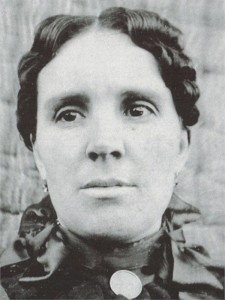 1893, when their new daughter Elsie Jane was born. They lived in the dugout until a home could be built. There were no towns close, so they had to rely on what they could hunt. Thankfully there was an abundance of deer, rabbits, turkeys, and even squirrels, so they never went hungry. Both Cornealius and Leola were excellent shots, so it didn’t matter who was available to hunt, both were able to get food for the family.
1893, when their new daughter Elsie Jane was born. They lived in the dugout until a home could be built. There were no towns close, so they had to rely on what they could hunt. Thankfully there was an abundance of deer, rabbits, turkeys, and even squirrels, so they never went hungry. Both Cornealius and Leola were excellent shots, so it didn’t matter who was available to hunt, both were able to get food for the family.
I can fully understand why it was so hard to make a homestead work now, because the supplies the homesteaders needed were not readily available. Many people gave up and headed back east, but my great grand uncle and his family stuck it out, and spent their remaining years in Oklahoma. They would raise their ten children there and were very successful in their endeavors. Homesteading wasn’t designed to be easy. Getting 160 acres of land is a big deal, and while the land ended up being free in the monetary sense, it certainly did not in the blood, sweat, and tears sense. The homesteader earned every inch of that property.
 I have often wondered what it must have been like when the first automobiles were starting to make their way onto the scene. I think that both the people and the horses, or other animals used to pull wagons, must have just about freaked out. People had no idea that such things were possible back then. And the horses…well, after the noise scared the daylights out of them, they probably took off like rockets…maybe inspiring future inventions.
I have often wondered what it must have been like when the first automobiles were starting to make their way onto the scene. I think that both the people and the horses, or other animals used to pull wagons, must have just about freaked out. People had no idea that such things were possible back then. And the horses…well, after the noise scared the daylights out of them, they probably took off like rockets…maybe inspiring future inventions.
I think that the first thought on peoples’ minds would be to distrust this new fangled contraption. They would wonder if it was going to run away like horses sometimes did, only there would be no reasoning with it or pulling on the reigns to stop it. Or, would it blow up…after all, it was a machine. Or, could it be dangerous…going out of control or rolling over. Maybe they thought all these things, but it’s quite possible that they simply thought that this new fangled machine was an unnecessary luxury…a waste of money…or maybe just for the rich people, who always seemed to be too extravagant anyway. People were used to being conservative with their supplies and their money.
Change is often a difficult thing to accept, and I can imagine that people like my great grandparents were pretty unsure of some of the new inventions that were showing up. They were used to their old ways, and it just seemed very extravigant to buy into these new things. Yes, change is hard to accept, but once we get used to it, many inventions turn out to be not only good things, but in many ways, such as with the automobile, they are destined to become something so necessary to life in this world, that it would be difficult to live without them.
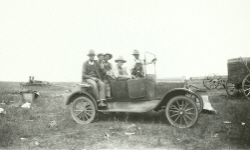
I like to think that my grandparents were among those who accepted change easily. I see them as people who had open minds, and who saw change for what it was…necessary. I like to think of them as the kind of people who wanted to be living in the present, with all it had to offer. Still, I have to wonder what they might think of some of the new fangled contraptions we have today, such as the cell phone, lap top, Kindle, iPhone, and iPad. If you suddenly put those things into the mid-1800’s…wouldn’t that just blow your mind.

